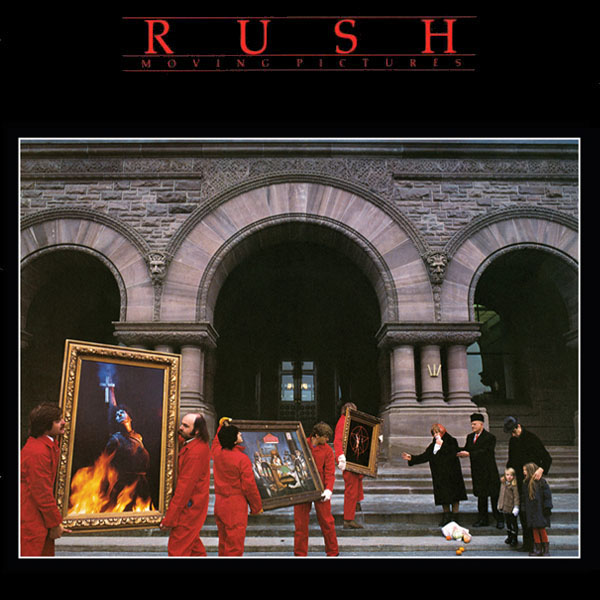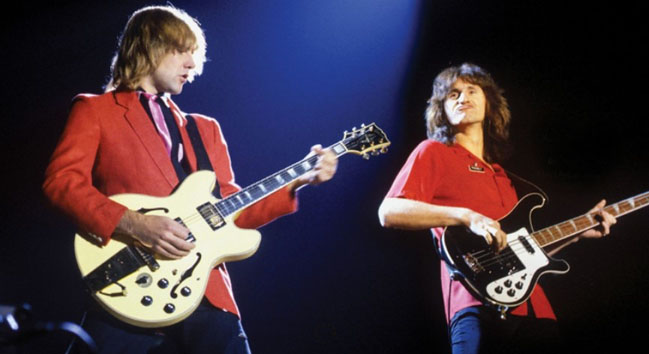The Universal Dream: Rush's Moving Pictures
By Bret Adams, Vintage Guitar, May 2020, transcribed by RushFanForever

In the worldwide milieu of Rush fans, casual types are rare. Rather, they tilt heavily to the obsessive. But if one fragment of the band's catalog draws the less-than-hardcore listener, it's the hugely successful Moving Pictures.
The 1981 album, boosted by the perpetual popularity of "Tom Sawyer," is widely considered the Toronto trio's masterpiece. It's also far and away their biggest seller - four million copies (and counting) in the U.S.
The eighth studio album from vocalist/bass guitarist Geddy Lee, guitarist Alex Lifeson, and drummer Neil Peart followed what the band felt was the peak for its hard-rock/ progressive-rock style epitomized by 1978's Hemispheres. For the follow-up, Permanent Waves, They wrote shorter, radio-friendly songs. Moving Pictures was the ultimate realization of Rush's new approach.
Terry Brown, who started working with Rush on its second album, Fly by Night, and continued to man the console as co-producer through 1982's Signals, knew Moving Pictures was a mainstream breakthrough.
"I certainly agree it's a masterpiece, but it's also one of many Rush albums that I'm fond of, so it's not the only record that I love," Brown said. "A Farewell to Kings is certainly one of my favorites... But yeah, Moving Pictures is up there."
The band's continued growth as instrumentalists and songwriters had obviously sharpened, and Brown was there to witness their progress.
"From record to record, they were always pushing themselves," he said. "They never sat and went, 'Hey, we're playing great. This will just be perfect.' They were always playing stuff that was difficult, but they would work at it until they got it. I always admired that quality in them."
Brown believes it's possible to get a sense that you're doing something special in recording an album, as he did while helping create Moving Pictures.
"A certain amount of realization is happening," he said. "You get a feel for what's going on."
"Tom Sawyer," now the band's best known song, exploded on radio airwaves and never left. Though not the band's highest-charting hit (peaking at #44 on the Billboard Top 40 singles chart), it was a game-changer.

"Undoubtedly, it had a unique quality," Brown noted. "Certainly, it was worthy of airplay, but of course, you never know whether that will happen. You don't know how the label is going to handle it or what the feedback will be from radio stations, or fans, for that matter. I loved it and was certainly very hopeful; I felt it was going to be popular because it's an ear-grabber."
The Grammy-nominated instrumental "YYZ" managed to be both musically complex and undeniably catchy, a fact borne out by the mass of air-drummers that would emerge during live performances.
"Obviously, Alex and Geddy stretch out, but it's a very strong tune," said Brown. "It's got great melody, they dug in, and all played really, really well."
The track shows off each member's individual talent as a soloist.
"I don't think we'd seen anything quite like it before from them," noted Brown. "Looking back, there were always great bass lines from Geddy that were just jumping out of the tracks, and certainly guitar riffs, lines, and solos from Alex would jump out. But 'YYZ' showcased everything really nicely. That was what really what caught people's ear."
Lifeson has said his solo on "Limelight" is a personal favorite. A multilayered tour de force, its long, dreamy vibrato bends give way to runs of crisp notes and a layered outro.
"It's a great solo, no doubt about it," Brown said. "But then, he's done a lot of great solos throughout his career! It's not like all of a sudden he hits pay dirt on 'Limelight.' But it was different from what he'd done before."
The 10-minute "The Camera Eye" appealed to fans who reveled in Rush's progressive leanings, but Brown does not think it was a conscious nod to long-timers.
"It came up conceptually and made a lot of sense. It gave us a lot of scope to do something different, a little more progressive and a little more outside. I think it balanced the record really nicely. We had 'Red Barchetta' and 'Limelight,' and these tunes that were, dare I say, 'poppy'-the more-commercial side of Rush. "The Camera Eye' certainly balanced it out."
While making Moving Pictures, Brown was learning the then-new digital mixing process, and wasn't sure how well it would work or affect the album's sound.
"We were breaking new ground, which was important to me," he said. "It sounded different. I was getting results I felt were closer to what I had intended, so I was happy."
Overall, for Brown, the album is just one piece in Rush's storied career, which was marked by consistency.